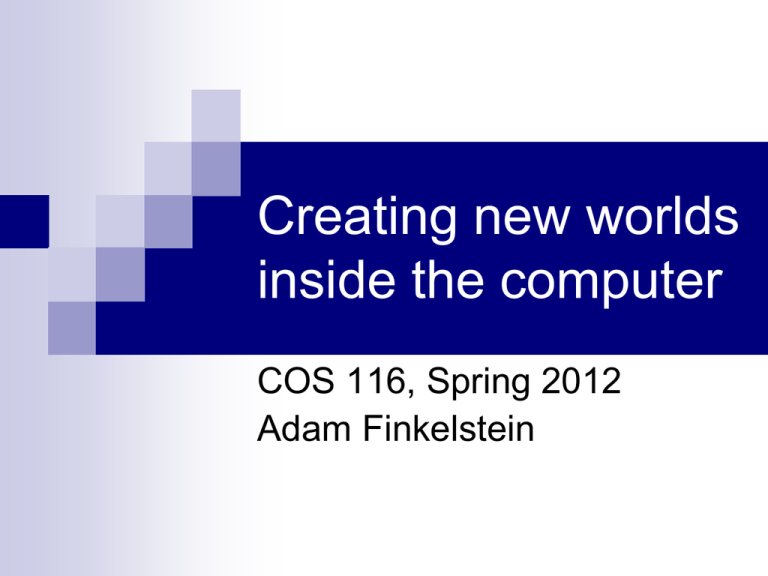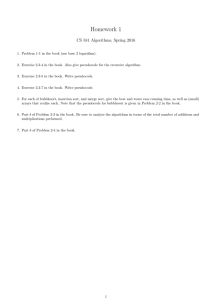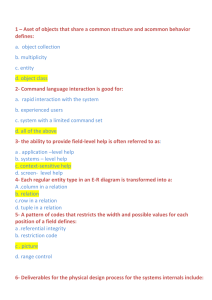Creating new worlds inside the computer COS 116, Spring 2012 Adam Finkelstein
advertisement

Creating new worlds
inside the computer
COS 116, Spring 2012
Adam Finkelstein
A couple tips….
Use Piazza! (Even for private questions.)
Send lab reports and homeworks to
pu.cos116@gmail.com
Pseudocode
Simple instructions: involve +, −, ×, ÷
Compound instructions
Conditionals
Loops
No need to sweat over exact wording during
exams (unless it changes meaning!)
See pseudocode handout on course web page
“Algorithm” - definition revisited
“Pseudocode for turning a set of inputs into
outputs in a finite amount of time”
Questions to think about:
What group of computational tasks
can be solved by algorithms?
How dependent is this group on
the exact definition of pseudocode?
Today’s topic:
Creating new worlds
inside the computer.
“simulation”
Conway’s Game of life
Rules: At each step, in each cell:
Survival: Critter survives if it has:
2 or 3 neighbors.
Death: Critter dies if it has:
1 or fewer neighbors, or more than 3.
Birth: New critter is born if cell is currently empty and
3 neighboring cells have critters.
Example
Discussion
Time
How would you write pseudocode that simulates
Game of Life?
Should use: n x n array A
(for desired n)
A[i, j] = 1 means critter in square
A[i, j] = 0 means empty square
Q: How do we “traverse” such an array using the “loop” construct?
Q: How do we update such an array for the next time step?
Pseudocode for each step
Do for i = 1 to n
{
Do for j = 1 to n
{
neighbors
A[i – 1, j - 1] + A[i – 1, j] + A[i – 1,j + 1] +
A[i, j – 1] + A[i, j + 1] +
A[i + 1, j – 1] + A[i + 1, j] + A[i + 1, j + 1]
if ( A[I,j] = 1 AND neighbors = 2 ) then
{ B[i, j] 1 }
else if (…)
…etc. //see handout; Example 3//
}
}
Do for i = 1 to n
{
Do for j = 1 to n
{ A[i,j]B[i,j] }
}
Lesson from the Game of Life?
Simple local behavior can lead to complex
global behavior
(See Brian Hayes article in readings.)
Next..
What does this pseudocode do?
Write on a piece of paper and hand it in.
n items, stored in array A
Variables are i, S.
S 0
Do for i = 1 to [n/2]
{
S S + A[2*i];
}
Twister simulation
Divide region into 3D array
Identify laws of physics for air
Navier Stokes equations:
How does a block of air move, given
pressure, temperature and velocity
differentials on boundary?
(“differentials” = difference from neighbors)
Simulator pseudocode
Initialize Grid using data from observations:
surface and aircraft measurements,
radar (NEXRAD) readings, etc.
Do for i = 1 to n
10ºC, 15 psi, 20% humidity
{
Do for j = 1 to n
11ºC, 15 psi, 23% humidity
{
etc.
Do for k = 1 to n
{ Update state of Grid[i, j, k] }
}
}
Other examples of simulation
[Turk 91] following:
Weather forecasting
Animation
Protein folding
How patterns arise in
plants and animals
Display
Q: How to display result
of simulation?
A: Computer graphics
(later in course)
[Enright and Fedkiw 02]
Physics of snow crystals
cooling
Water vapor
further cooling
Water
Snow
crystals
“Cooling” – reduce amount of molecular motion
Crystal growth: capture of nearby floating molecules
Bigger questions
Alan Turing
Albert Einstein
Can computer simulation be replaced by a
“theory of weather”? A “theory of tornadoes”?
Is there a “theory” that answers this type of problem:
Given: A starting configuration in the game of life
Output: “Yes” if the cell at position (100, 100) is ever occupied,
“No” otherwise
Actually, reverse trend:
“theory of matter” (particle physics)
is becoming computational.
1670 F = ma
Today
Hayes (reading this week):
The universe as a “cellular automaton”
Peeking ahead:
A computer can simulate another computer
(e.g., a Classic Mac simulator on a PC).
Will explore the implications of this in a future lecture.
Game of life is actually a “computer.”
Readings for this week: (i) Brian Hayes article; first 5 pages
(ii) Brooks 99-126
HW 2 Due next Thurs.





